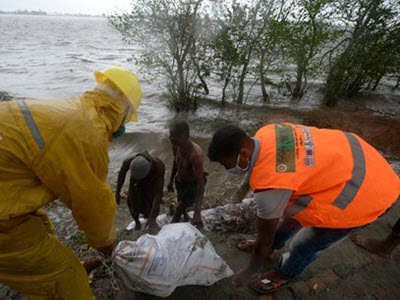Building Resilience in Coastal Communities
Perspectives from the Bay of Bengal
Mohammad Mahmodul Hasan argues that Bangladesh, as a country that is especially vulnerable to natural disasters, must implement a comprehensive disaster management approach. He emphasizes the need to prioritize policy and management strategies, community disaster preparedness, and public awareness.
Bangladesh is highly vulnerable to climate change and natural disasters due to the three major rivers running through the country and draining into the cyclone-generating Bay of Bengal. It is particularly sensitive to rising sea levels, cyclones, tidal surges, saline intrusion, irregular rainfall, drought, and flooding. Bangladesh is placed seventh among the countries most affected by extreme weather events, which ultimately harm people’s lives and livelihoods, particularly in coastal regions, according to the Global Climate Risk Index for 2021.
Beginning with the Bhola Cyclone in 1970 that killed 1 million people and Cyclone Gorky in 1991 that killed around 130,000 people and left 10 million people homeless, Bangladesh’s history with disasters has been deadly. Cyclone Sidr in 2007 and Cyclone Aila in 2009 were similarly devastating. Yet in the last decade the country has become more resilient to natural disasters. Cyclone Mahasen in 2013, Cyclone Bulbul in 2019, Cyclone Amphan in 2020, and Cyclone Yaas in 2021 were more powerful but killed fewer than 1,000 people in total, largely due to increased resiliency and preparedness efforts.[1] These storms, however, still made millions homeless and damaged crops, infrastructure, and embankments. Bangladesh has faced an economic loss of more than $12 billion during 1975–2015, depressing GDP annually by 0.5% to 1%.[2]
Additionally, sea levels have continued to rise, and saline water has frequently intruded into drinking water sources, irrigation systems, and soil. Three years after Cyclone Sidr, residents in numerous districts were still unable to farm their property. Saline water intrusion and prolonged flooding have slashed crop yields, and crop, livestock, and fishery production suffers, significantly affecting the textile and food-processing industries. Water sources for drinking purposes were contaminated with saline, women were forced to go several kilometers to get drinking water, and saline water–borne illness was prevalent in such areas. As a result of natural disasters, people and livestock alike lost their places of residence and grazing grounds. Many were forced to leave their houses and homelands, resulting in large populations of internally displaced persons as well as climate migrants to the rest of the country and beyond.
Bangladesh’s efforts to transform its approach to disaster management from a reactive relief-based approach to one that emphasizes proactive integrated management have reduced these impacts from natural disasters. Preparedness, mitigation, response, and recovery have become ingrained as disaster risk reduction (DRR) procedures in the majority of policies, plans, and operational frameworks. This vision is further embodied through the Ministry of Disaster Management and Relief, alongside the Department of Disaster management, both of which are responsible for coordinating national disaster management efforts across relevant ministries and agencies in the government.
DISASTER POLICIES, PLANS, AND WORKING FRAMEWORK
The national disaster risk management is directed by Bangladesh’s long-term perspective plans—“Vision 2021” and “Vision 2041”—with the broader target of gradually rising to become a developed country. Moreover, the 100-year plan in the Bangladesh Delta Plan 2100 and the implementation of the action plan in the 8th Five-Year Plan (2021–25) have emphasized disaster risk management in relation to resilience building. Bangladesh is also party to many international agreements, such as the Hyogo Framework for Action and the Paris Agreement, which prioritize disaster risk reduction efforts. Finally, as part of the Sendai Framework for Disaster Risk Reduction (2015–2030), nations like Bangladesh have been given the opportunity to expand their disaster risk reduction efforts by tackling environmental, technical, and biological hazards and dangers.
This history of disasters has caused Bangladesh to establish several avenues for managing the associated risks. These include the National Plan for Disaster Management, Standing Orders on Disaster, and Cyclone Preparedness Program.
A major goal of the National Plan for Disaster Management over 2021–25 is to ensure that disaster management legislation and the Standing Orders on Disaster are implemented effectively, while allowing ministries and other government agencies to use the national plan to produce annual work plans that incorporate a whole-of-society approach. Revisions to the Standing Orders on Disaster 2019 include participation of experts from a variety of fields, such as water resources, climate change, disaster management, and gender and social inclusion, among others in the National Disaster Management Advisory Committee. The committee is responsible for developing policies and providing guidance. There are thirteen ministers in the National Disaster Management Council, which is a supreme body of disaster management headed by the prime minister.
In the international sphere, Bangladesh has a history of bilateral cooperation and the opportunity to increase this cooperation to become multilateral. One of the earliest bilateral mechanisms regarding water resources, the Joint River Commission (JRC), was formed in 1972 between Bangladesh and India, allowing the sharing of information on water resources, flood-related data, and cyclones. This JRC is also entrusted to work jointly with Nepal as well as China for the trans-boundary rivers. The meteorological departments of both Bangladesh and India share information, which contributes significantly to forecasting tropical cyclones generated in the Bay of Bengal. Existing regional organizations could improve multilateral collaboration. The Centre on Weather and Climate of the Bay of Bengal Initiative for Multi-Sectoral Technical and Economic Cooperation (BIMSTEC), for example, could act as a vital player, providing scientific data and capacity building in South and Southeast Asia.
INTERVENTIONS IN DISASTER MANAGEMENT
Bangladesh has invested more than $10 billion to build resilience to disasters. This includes investment in greater community capacity; stronger river embankments; hard infrastructure like roads, bridges, and cyclone shelters; and early warning and emergency management systems.[3] Various departments of the Bangladesh government and NGOs have collaborated on disaster management since the country’s birth in 1971. The following discussion surveys a few of these initiatives.
Access to drinking water. A top priority has been quickly restoring access to drinking water after natural disasters. Over the previous two decades, drinking water had been delivered to the local community through rainwater harvesting at the household level with a water reserve tank, large-volume water reserve facilities at the community level, and community-based pond-sand filtration systems. A resident in the coastal area of Shyamnagar noted that after Cyclone Aila in 2009 it took him four hours to find half a glass of water. By contrast, in the aftermath of Cyclone Amphan in 2020, he had three options to get drinking water—a rainwater reserve tank, pond-sand filtration, and a solar-powered reverse osmosis plant—showing that these efforts have had a tangible impact.
Additionally, numerous ponds and canals have been excavated to provide water for home usage and protect water sources against saline-water incursion caused by storm surges or other natural phenomena. Thousands of kilometers of polder embankment in Bangladesh’s coastal belts have been repaired and reconstructed with necessary connecting sluice gates as part of the Coastal Embankment Improvement Project to maintain tidal flow and protect the locality and agricultural fields from storm surges and floods.
Protecting agriculture. Because freshwater scarcity is a problem in Bangladesh’s coastal region, numerous sustainable irrigation methods have been created, and comprehensive agriculture practices have widely been adopted by farmers. Farmers and members of the local community are provided with saline- and flood-tolerant seeds for cultivation as part of the post-disaster rehabilitation process in agriculture. The government organizations and NGOs offer agricultural technologies, fertilizers, and money as part of the food security effort. Additionally, women utilize open space in their yards for disaster-resilient homestead gardening to ensure food security even in the aftermath of a disaster. In the last two decades, significant afforestation and reforestation efforts have also begun.
Empowering local communities. The local community has been integrated into co-management of disaster risk reduction. Different government organizations, NGOs, and other stakeholders closely work with the community in the disaster preparedness, response, and recovery phases. For example, to complement the numerous existing cyclone shelters, the construction of multipurpose renewable energy-powered shelters for the coastal communities is underway. The well-established Cyclone Preparedness Program has strengthened its network and interventions through signal distribution, disaster preparedness capacity-building training (including mock-drills), and community awareness building.
The ultimate goal of many NGOs is to build disaster- and climate-resilient communities. In Bangladesh, many community-based organizations have been formed to include the voices of vulnerable people and incorporate indigenous knowledge and culture—all of which contribute to building the community’s resilience.
Additional considerations for successful disaster risk reduction. The impact of disasters varies across society, but women, children, and other marginalized groups bear the brunt of disasters. This frequently exacerbates already-existing disparities in society. Disasters in coastal Bangladesh reinforce early marriage and increase violence against women by heightening social and economic instability and insecurity. All these difficulties underscore the critical importance of integrating gender perspectives into disaster management, risk reduction, and sustainable development processes, with the ultimate goal of achieving gender equality. To begin, it is critical to have gender-disaggregated data in order to make informed decisions. Second, including gender analysis enables the identification of distinct gender or social group requirements and capacities. Third, gender mainstreaming in institutional development as well as capacity building is essential to achieve the desired transformation in society. What matters most is the proper implementation of all policies and planning.
Covid-19 has placed a new load on the world’s shoulders. In the aftermath of Cyclone Amphan and flooding in 2020–21, social distancing, mask use, health hygiene, and security were difficult to maintain in overcrowded cyclone shelters, which threatened existing risk reduction programs. It is imperative that lessons learned during the pandemic are incorporated into the current policy framework. The Ministry of Disaster Management and Relief and various NGOs distributed healthcare and hygiene products like face masks, hand gloves, disinfectant, soap, and wash basins for hand washing in cyclone shelters. As the lockdown continued, NGO and civil society organizations proposed a revised form of aid response that includes more things related to health and food. However, there are many additional lessons from these cyclones and floods that demand prompt, well-focused policy to address the needs of vulnerable populations in Bangladesh.[4]
CONCLUSION
For Bangladesh’s long-term prosperity, disaster prevention and preparedness are essential. Considering natural disasters and climate change as development constraints is becoming more common. Therefore, policies and practices for addressing them are becoming more relevant.
Climate change and natural disasters are mutually reinforcing threats that can no longer be treated in isolation from one another. Those living in Bangladesh’s vulnerable coastal areas should pay particular attention. Preparedness and adaptation strategies can be developed using disaster management technologies to help local communities better understand the hazards they face. Moreover, lessons learned from the Covid-19 pandemic should be incorporated into existing policies and implementation plans. More generally, a comprehensive disaster management approach must be implemented, which means prioritizing policy and management strategies, community disaster preparedness training advocacy, and public awareness.
Mohammad Mahmodul Hasan is Coordinator of the Climate Change Program in the Christian Commission for Development in Bangladesh. He focuses on climate change issues, disaster management, adaptation and mitigation technologies, renewable energy, energy and environmental policy, community resilience building, social mobilization, and sustainable village development.
Endnotes
[1] Mahbuba Nasreen, “Fifty Years of Disaster Risk Governance in Bangladesh,” Daily Star, March 26, 2021, https://www.thedailystar.net/supplements/celebrating-50-years-bangladesh/news/fifty-years-disaster-risk-governance-bangladesh-2067109.
[2] “Bangladesh: Building Resilience to Climate Change,” World Bank, October 9, 2016, https://www.worldbank.org/en/results/2016/10/07/bangladesh-building-resilience-to-climate-change.
[4] See UN Bangladesh and Ministry of Disaster Management and Relief (Bangladesh), “HCTT Nexus Strategy (2021–2025): Humanitarian-Development Collaboration for Climate-Related Disasters in Bangladesh,” August 2021, https://reliefweb.int/sites/reliefweb.int/files/resources/draft_hctt_draft_nexus_strategy_september_26_kazi.pdf.



